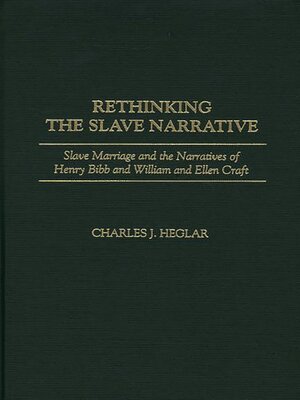Rethinking the Slave Narrative
ebook ∣ Slave Marriage and the Narratives of Henry Bibb and William and Ellen Craft · Contributions in Afro-American and African Studies: Contemporary Black Poets
By Charles J. Heglar

Sign up to save your library
With an OverDrive account, you can save your favorite libraries for at-a-glance information about availability. Find out more about OverDrive accounts.
Find this title in Libby, the library reading app by OverDrive.



Search for a digital library with this title
Title found at these libraries:
| Library Name | Distance |
|---|---|
| Loading... |
The African American slave narrative is popularly viewed as the story of a lone male's flight from slavery to freedom, best exemplified by the Narrative of the Life of Frederick Douglass, An American Slave (1845). On the other hand, critics have also given much attention to Harriet Jacobs's Incidents in the Life of a Slave Girl (1861), to indicate how the form could have been different if more women had written in it. But in stressing the narratives of Douglass and Jacobs as models for the genre, scholars have ignored the formal and thematic importance of marriage and family in the slave narrative, since neither author explores slave marriage in their works.
This book examines the central role of marriage in The Life and Adventures of Henry Bibb, an American Slave (1849) and Running a Thousand Miles for Freedom; or the Escape of William and Ellen Craft from Slavery (1860). Bibb's slave wife and child account for significant innovations in the form and content of his narrative, while the Crafts' mutual dependence as a married couple results in a sustained use of dramatic irony. The volume closes by offering a thoughtful consideration of the influence of Bibb and the Crafts on the later fiction of Douglass, William Wells Brown, and Martin Delany. In doing so, it invites a critical reexamination of current assumptions about slave narratives.
This book examines the central role of marriage in The Life and Adventures of Henry Bibb, an American Slave (1849) and Running a Thousand Miles for Freedom; or the Escape of William and Ellen Craft from Slavery (1860). Bibb's slave wife and child account for significant innovations in the form and content of his narrative, while the Crafts' mutual dependence as a married couple results in a sustained use of dramatic irony. The volume closes by offering a thoughtful consideration of the influence of Bibb and the Crafts on the later fiction of Douglass, William Wells Brown, and Martin Delany. In doing so, it invites a critical reexamination of current assumptions about slave narratives.







